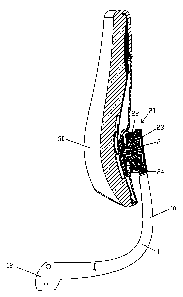Some of the information on this Web page has been provided by external sources. The Government of Canada is not responsible for the accuracy, reliability or currency of the information supplied by external sources. Users wishing to rely upon this information should consult directly with the source of the information. Content provided by external sources is not subject to official languages, privacy and accessibility requirements.
Any discrepancies in the text and image of the Claims and Abstract are due to differing posting times. Text of the Claims and Abstract are posted:
| (12) Patent Application: | (11) CA 2606360 |
|---|---|
| (54) English Title: | BACK REST FOR A CHAIR |
| (54) French Title: | DOSSIER DE CHAISE |
| Status: | Deemed Abandoned and Beyond the Period of Reinstatement - Pending Response to Notice of Disregarded Communication |
| (51) International Patent Classification (IPC): |
|
|---|---|
| (72) Inventors : |
|
| (73) Owners : |
|
| (71) Applicants : |
|
| (74) Agent: | MARKS & CLERK |
| (74) Associate agent: | |
| (45) Issued: | |
| (22) Filed Date: | 2007-10-09 |
| (41) Open to Public Inspection: | 2008-04-18 |
| Examination requested: | 2008-10-10 |
| Availability of licence: | N/A |
| Dedicated to the Public: | N/A |
| (25) Language of filing: | English |
| Patent Cooperation Treaty (PCT): | No |
|---|
| (30) Application Priority Data: | ||||||
|---|---|---|---|---|---|---|
|
For a back rest for a chair with a back support (10) and a back surface (30)
secured to
this and able to swivel about a two-axis joint (20), wherein the joint (20)
has a joint plate
(21) connected to the back surface, an element made of an elastic material
that
supports the joint in a ground position, and a chamber 24 to accommodate the
elastic
element, connected to the back support (10), the invention specifies that the
joint plate
(21) is arranged in the receiving chamber (24) between two elements (22, 23)
made
from an elastic material, holding the joint in a ground position and each
being supported
against the receiving chamber (24), and it can swivel about the two swivel
axes. When
the joint (20) is placed under load, the two elastic elements (22,23) are only
subjected
to compression. There are no tension-loaded connections, as in the prior art,
which
break under loading and can result in the joint falling apart.
Note: Claims are shown in the official language in which they were submitted.
Note: Descriptions are shown in the official language in which they were submitted.

2024-08-01:As part of the Next Generation Patents (NGP) transition, the Canadian Patents Database (CPD) now contains a more detailed Event History, which replicates the Event Log of our new back-office solution.
Please note that "Inactive:" events refers to events no longer in use in our new back-office solution.
For a clearer understanding of the status of the application/patent presented on this page, the site Disclaimer , as well as the definitions for Patent , Event History , Maintenance Fee and Payment History should be consulted.
| Description | Date |
|---|---|
| Time Limit for Reversal Expired | 2011-10-11 |
| Application Not Reinstated by Deadline | 2011-10-11 |
| Deemed Abandoned - Failure to Respond to Maintenance Fee Notice | 2010-10-12 |
| Amendment Received - Voluntary Amendment | 2010-08-27 |
| Inactive: S.30(2) Rules - Examiner requisition | 2010-03-12 |
| Amendment Received - Voluntary Amendment | 2009-08-14 |
| Letter Sent | 2008-11-13 |
| Request for Examination Requirements Determined Compliant | 2008-10-10 |
| Request for Examination Received | 2008-10-10 |
| All Requirements for Examination Determined Compliant | 2008-10-10 |
| Application Published (Open to Public Inspection) | 2008-04-18 |
| Inactive: Cover page published | 2008-04-17 |
| Inactive: First IPC assigned | 2008-03-11 |
| Inactive: IPC assigned | 2008-03-11 |
| Inactive: Filing certificate - No RFE (English) | 2007-12-07 |
| Application Received - Regular National | 2007-11-20 |
| Abandonment Date | Reason | Reinstatement Date |
|---|---|---|
| 2010-10-12 |
The last payment was received on 2009-10-07
Note : If the full payment has not been received on or before the date indicated, a further fee may be required which may be one of the following
Patent fees are adjusted on the 1st of January every year. The amounts above are the current amounts if received by December 31 of the current year.
Please refer to the CIPO
Patent Fees
web page to see all current fee amounts.
| Fee Type | Anniversary Year | Due Date | Paid Date |
|---|---|---|---|
| Application fee - standard | 2007-10-09 | ||
| Request for examination - standard | 2008-10-10 | ||
| MF (application, 2nd anniv.) - standard | 02 | 2009-10-09 | 2009-10-07 |
Note: Records showing the ownership history in alphabetical order.
| Current Owners on Record |
|---|
| SEDUS STOLL AKTIENGESELLSCHAFT |
| Past Owners on Record |
|---|
| HARRY FISCHER |
| PETER MAIER |